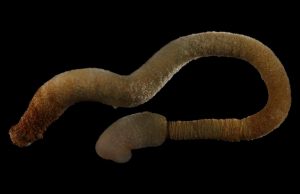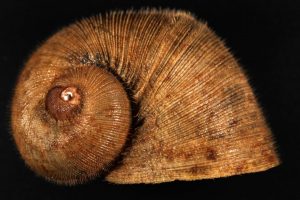History
The Invertebrate Zoology (IZ) collection, which deals with all animals without backbones except hexapods, arachnids, and crayfish, was established in the 1960s by the late Dr. Thomas S. Hopkins. With additional contributions from his successors, Drs. Charles Lydeard, Daniel Graf, and Kevin Kocot (the current curator), this collection has grown to nearly 20,000 catalogued lots of marine, freshwater, and terrestrial invertebrates. The vast majority of the specimens in the IZ collection are benthic marine invertebrates collected through work conducted by Dr. Thomas Hopkins in the Gulf of Mexico and Caribbean, but we hold specimens from every continent on Earth representing at least 15 animal phyla.
Collection Summary and Highlights
Most notable are large collections of crustaceans (~11,000 lots, mostly from the Gulf of Mexico), echinoderms (~5,000 lots), and freshwater mussels (~4,000 lots). Most specimens in the Invertebrate Zoology collection are wet specimens that were initially fixed in formalin and are stored in ethanol, another roughly 2,500 specimens are dried, and a growing collection of tissue samples (mostly from freshwater bivalves) are frozen at -80°C and are thus suitable for molecular work.
Since joining UA in 2016, Dr. Kocot has been actively growing the collections. In 2016, he participated in a benthic marine invertebrate sampling expedition in the Weddell Sea of Antarctica and collected 560 lots of specimens (mostly marine molluscs) that will be integrated into the collection. In 2020 he led a second, larger expedition to Antarctica that collected over 2,500 lots of specimens, most of which are suitable for molecular work. Planned sampling efforts by Dr. Kocot will continue to grow this collection, especially in the area of marine malacology (molluscs) and microscopic invertebrates (meiofauna).
Uses of the Collection
All specimens in the collection are available for research or exhibition. Student researchers must have loans requested by their adviser. Researchers may visit the collection or request a loan. Since January 2016, only a handful of loans of specimens have been made for research. However, making the data publicly available on Arctos in mid-2020 has significantly increased awareness of the IZ collection and we welcome any and all inquiries. This rich collection of diverse specimens has several notable taxonomic strengths and considerable potential for use in diverse research ranging from systematics to ecology. In particular, because of the geographical breadth and depth of sampling in the Gulf of Mexico, this collection has particular significance to ecological studies in this region and could provide important information on baseline species distributions in this region before e.g., the 2011 oil spill and ongoing global change.
Browse the Collection
Specimens digitized to date are searchable via Arctos: https://arctos.database.museum/
Looking for something but don’t see it on Arctos? Please contact the curator for more information!
People and Information
- Dr. Kevin M. Kocot, Curator of Invertebrate Zoology
- Brooke Bogan, Collections Manager of Natural History
Feel free to contact the curator if you would like to become a volunteer or intern in the collection to help curate the collection, learn more about invertebrates, and acquire diverse skills ranging from macro photography to specimen preservation to data husbandry and analysis.


